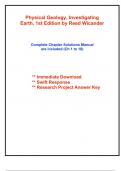Physical Geology, Investigating
Earth, 1st Edition by Reed Wicander
Complete Chapter Solutions Manual
are included (Ch 1 to 18)
** Immediate Download
** Swift Response
** Research Project Answer Key
,Earth Systems, Geology, and a Habitable Planet: An Introduction to Science and Element Cycling
Chapter 1 Research Project Answer Key
Part 1 Earth System Science
Video Activity: How Earth Systems Interact
1. List the four major subsystems of Earth and give examples of components of each.
Answers will vary. Examples may include:
Geosphere (rock, lithosphere, soil, sediment, sand, lava, magma, core, etc.)
Hydrosphere (ice, water vapor, rivers, glaciers, oceans, lakes, streams, groundwater,
aquifers, clouds, etc.)
Atmosphere (oxygen, nitrogen, trace carbon dioxide, trace argon, trace neon, trace,
methane, trace ozone and other trace gases)
Biosphere (hippo, ants, water lilies, forests of any type, whales, bacteria, jellyfish, humans,
polar bears, tortoises, lady bugs, etc.)
2. What “sphere” are humans a part of?
Biosphere, and within that, humans are part of a sub-sphere called the Anthrosphere.
3. What are two sources of Earth’s energy?
The Sun sends light energy (electromagnetic radiation), and the core emanates heat
(thermal) energy toward the surface.
4. Which fossil fuels are mentioned?
Coal, oil, and natural gas
5. Give a simple definition of an “ecosystem,” according to the video.
Regions where organisms actively interact with each other and their environment.
6. List several “ecosystems services.”
Climate regulation, cycling and purification of water, development and maintenance of
soils.
© 2023 Cengage. All Rights Reserved. May not be scanned, copied or duplicated, or posted to a publicly accessible website,
in whole or in part.
, 7. How can geoscientists “see” Earth system interactions?
By looking at the geologic record (rock and fossils considered in temporal succession)
Reading Activity: How Earth Systems Operate
1. How does science begin?
By identifying a feature or problem and wondering about its origins or causes.
2. What molecules that include carbon as a component are mentioned above?
Carbon dioxide (CO2), chlorofluorocarbons (CFCs), volatile organic compounds (VOCs)
3. How long ago did scientists discover the basic gases responsible for atmospheric warmth,
now termed “greenhouse gases”?
Answers may vary, but should indicate the passage was read/understood. Sample answer:
Noteworthy early recognition was in 1824 and 1865, with John Tyndall in 1859 describing
specifically CO2 as a gas that could affect atmospheric warmth. In 1896, the first calculations
about CO2 contribution to atmospheric warmth were made.
4. How long ago did scientists begin to describe that increasing carbon dioxide levels would
cause atmospheric warming?
Answers may vary, but should indicate the passage was read/understood. Sample answer:
John Tyndall in 1859 described CO2 as a gas that could affect atmospheric warmth. In 1896,
the first calculations about CO2 contribution to atmospheric warmth were made.
5. How would CFC-caused destruction of ozone and increasing levels of atmospheric CO2
interact?
a. The two gases add to each other’s effect, increasing energy within the atmosphere.
b. The two gases cancel each other out, as one gas lowers energy while the other
increases it.
c. The two gases add to each other’s effect, reducing energy within the atmosphere.
d. The two gases have no effect on the level of energy in the atmosphere.
Guided Investigation 1: Water in Minerals
Water-containing minerals, as noted from the Mindat.org website:
© 2023 Cengage. All Rights Reserved. May not be scanned, copied or duplicated, or posted to a publicly accessible website,
in whole or in part.




